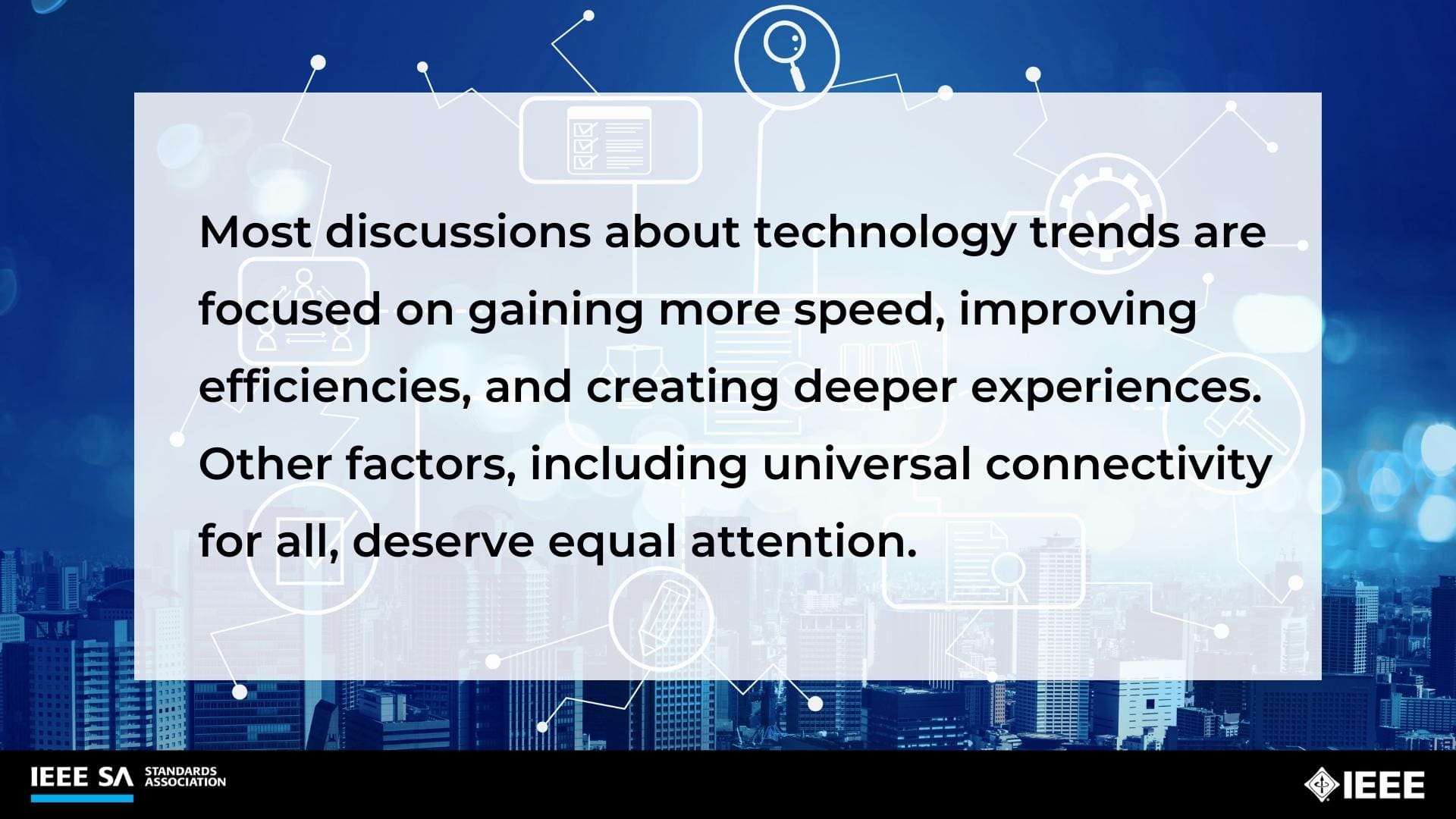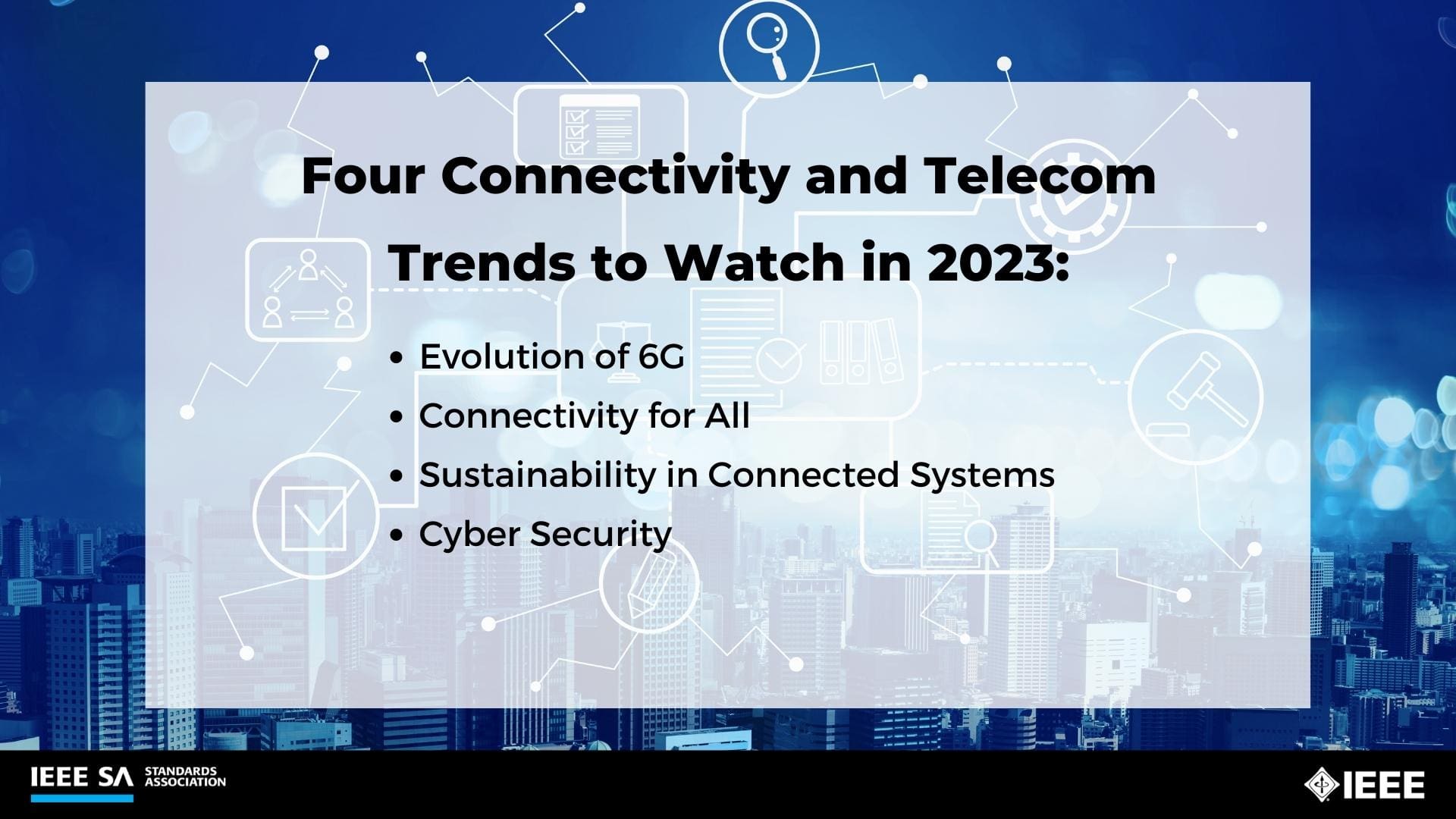Highlights:
- Beyond the need to amplify applications for better connectivity and performance, future networks should be designed with improved sustainability intentions, security that fosters trust and reliability, and the ability to expand and/or improve connectivity to remote areas of the world.
- As we look toward 2023, we can see the advancement of multiple technologies, which will dramatically impact connectivity.
In the United States, almost all adults ages 18 to 49 use the internet and 75% of those 65 and older are internet users. However, 24 million Americans lack access to high-speed internet due to gaps in digital inequality and literacy and affordability of internet services. As a result, more than 21 million people who are mostly living in rural areas or underserved neighborhoods remain in the ‘cyber dark’.
Globally, the number of internet users worldwide is about 4.9 billion people, which means that about one third of the global population is not connected to the world wide web. While some governments aim to help by funding infrastructure and offsetting user costs, carriers also can take new approaches and leverage technological innovations to help lower infrastructure capital and operating costs.
Emerging from the worst of the COVID-19 pandemic, we can all agree that society recognizes and insists upon improved connectivity, but the pandemic also impacted the needs and wants of organizations. We saw digitization and automation become a priority with increased remote work during the pandemic, and that push continues. Emerging technologies, such as artificial intelligence (AI) and machine learning (ML), continue to mature and gain adoption. For example, worldwide AI software revenue is forecast to total $62.5 billion in 2022, an increase of 21.3% from 2021.
Organizations and consumers continue to drive advancements in virtual experiences, IoT devices, remote monitoring, and autonomous vehicles. At the root of these demands is the need for greater connectivity improvements – faster speeds, lower latencies, and enhanced security – influencing advancements towards 6G, Wi-Fi 7, supercomputing, and more.
The need for better global connectivity, as well as many other challenges in connectivity and telecommunications, are factors that drive the work of the IEEE Standards Association (IEEE SA) in this industry.
As we look toward 2023, we can see the advancement of multiple technologies, which will dramatically impact connectivity. Most discussions about technology trends such as 6G, Wi-Fi 7, AI, and others, are focused on gaining more speed, improving efficiencies, and creating deeper experiences. Rightfully so, but other factors deserve attention including a need for expanding global connectivity, a problem significantly exposed during the worst of the COVID-19 pandemic.

1) Evolution of 6G, including O-RAN and Wi-Fi
6G, as the name suggests, is the sixth generation of mobile connectivity. Beyond 5G, the next generation of mobile communication systems is expected to have features that contribute to the creation of sustainable and new value, such as ultra-low power consumption, ultra-security and reliability, autonomy, and scalability.
Beyond the obvious need to amplify applications for better connectivity and performance, including the increase in adoption of artificial intelligence (AI) and machine learning (ML) in numerous applications across all industry sectors, tomorrow’s 6G network should be designed with improved sustainability intentions, security that fosters trust and reliability, and the ability to expand and/or improve connectivity to remote areas of the world. But these desires bring financial challenges; the slow adoption of 5G is not encouraging, and service providers must determine how to monetize 6G to justify their investment.
The COVID-19 pandemic was the catalyst in which it became acutely clear that future networks must put more emphasis on societal and economic needs by making the network bigger instead of focusing only on performance. There are many areas globally, particularly rural and underprivileged areas, without broadband access. A network that could become universal is of great importance to IEEE SA.
To strive towards this goal, future networks will need to serve an ever-increasing number of users and subsequent traffic in a cost-effective way. 6G satellite technology and intelligent surfaces capable of reflecting electromagnetic signals will deliver low latency, multi-gigabit connectivity. This is especially transformative for the parts of the world where it has been too difficult or too expensive to reach with conventional mobile networks.
The advance of Open RAN (O-RAN) also should help drive down network costs. Open RAN technology is enabling innovation across applications, including virtualization, software-defined networking, and separation of the control plane and user plane. This will enable the dis-aggregation of networks.
Lastly, while 6G gets most of the buzz, let’s remember the rapid advances in Wi-Fi technology. Currently, Wi-Fi 7 standards development is underway and expected to publish in 2024. The demand drivers for faster Wi-Fi include the desire to support 4K to 8K video resolution for high-throughput, low-latency applications such as augmented reality (AR), virtual reality (VR), and cloud computing.
IEEE SA is building an ecosystem of stakeholders from across the globe to address the need for advancement and applications of 6G. Other technologies and societal issues envisioned for 6G technology include: virtualized RAN or open RAN, universal connectivity for rural communities, energy savings, cyber security, the Internet of Things (IoT), AR, and a sustainable future.
2) Connectivity for All
We have reached the point where most people realize connectivity is important and see its value. In the United States, for example, innovative solutions are being leveraged to take action to fund to bring broadband to more communities, particularly in rural and unserved communities that often lack the business case for commercial internet service provider investments. In some states, electric cooperatives and regional utility districts are providing broadband and investor-owned utilities are improving the availability of critical infrastructure.
But the rate of adoption is still lagging from a global perspective. Rural areas in many parts of the world, two years after the pandemic, are still not connected.
And as previously noted, the use of renewable energy resources to power infrastructure in areas without electricity is gaining increased interest.
By way of Connectivity & Telecom Practice, IEEE SA is working to advance the goal of global digital inclusion through several initiatives. The Rural Communications Industry Connections (IC) Activity, for example, is intended to contribute toward the goal of global digital inclusion by developing solutions for rural and remote areas using suitable technologies. Another IC activity, User-Centered Approach to Designing a User Interface for Rural Communities, aims to research the technology needs of global rural communities, which will help to develop a model for the design and implementation of user interfaces for rural communities.
3) Sustainability in Connected Systems
For years, there’s been a movement towards renewables to lessen our dependence on fossil fuels for energy or transportation. Even in households, we’re seeing more solar panels on rooftops and electric cars in driveways. But now, we’re starting to see the acceleration of leveraging renewable energy sources – solar, wind, and water – to help build and maintain infrastructure including wireless networks. While carbon footprint reduction is a noble effort, cost reduction also is a motivating factor.
The IT network consumes the most energy in the content delivery process. From the service provider’s perspective, capital and operating costs are the financial guideposts of investment, and these costs must be recovered to be profitable. We are seeing an increased interest in the use of renewable energy sources to power infrastructure in areas where electricity is not available, thus enabling possibilities for connectivity in areas not considered before.
For example, a solar-powered cell tower might now be present in an area without electricity. But service providers also seek to reduce operating costs, particularly with the more demanding infrastructures required to support 5G. Renewable energy sources used to operate, as examples, base stations, and towers, can reduce overall operating energy costs.
Other factors are coming into play which are influencing the interest and adoption of renewable energy, including climate change. We are seeing dramatic shifts in weather events, such as historic drought in the Pacific Northwest of the United States but also in many parts of Europe. For example, in areas of severe drought where water is used to generate power but also needed for agriculture and potable water for community residents, difficult decisions must be made which may include the adoption of renewable energy sources to augment hydropower. These and other factors are driving stronger conversations, innovations, and adoptions of renewable energy as alternatives to augment or replace existing energy sources.
Planet Positive 2030 is an IC activity created by a global, open community of experts supported by IEEE SA. Another IC activity, Sustainability for Connectivity & Telecom Systems, engages industry experts to develop standards and related solutions for Information and Communications technologies (ICTs).
4) Cyber Security
Given the fast pace with which digital technologies are becoming central to the human daily experience and with the advent of new technologies, data, and the digital infrastructure must be protected, no matter where it resides.
We must plan and prepare for the future of cyber security while managing current security requirements, thus fueling our focus on evaluating and rethinking architectures that enhance cyber security in digital systems. Data collection, storage, processing, and its flow on networks must be reimagined to arrive at true Zero Trust architectures that aim to address cyber threats at all levels.
Growing cyber security threats to today’s computing and communications systems are a result of the following factors:
- Data creation and transmission are exploding in both the enterprise and consumer spaces, yet data flow and data management aren’t consistently implemented.
- Organizations have many disparate applications and services from many vendors, but the dependencies of these applications on each other are not always well understood by the organizations, nor are the contents of an application or a service.
- New technologies, applications, and devices are being introduced every day to collect and process data, but it is unknown which data is being collected, how it is being collected, and where it is being stored and processed.
- Next-generation communications systems may lead to more risks from less secure data transmission.
- Centralized data collection creates honeypots of information that can be breached by bad actors.
In response to these concerning issues, IEEE SA has formed the Cyber Security for Next-Generation Connectivity Systems IC Activity to better understand how to mitigate their impact. It is especially timely because the potential points of vulnerability have dramatically increased in recent years as more people work remotely.

Get Engaged with IEEE SA
As we usher in a new year, we can expect to see continued advancement of efforts and technology evolutions leading towards our efforts to bring and improve connectivity to everyone, everywhere.
IEEE SA works across industries and sectors to drive worldwide participation and champion the benefits of open standards and solutions, accelerating their adoption and the advancement of technology. We offer a full ecosystem of products, programs, and services, which includes:
- Standards development leveraging IEEE SA’s neutral and inclusive platform and process.
- Industry Connections (IC) program enabling exploration of emerging technologies to incubate new standards and solutions.
- Conformity Assessment and Certification program to speed up market adoption of standards and build confidence in product functionality and safety.
- IEEE SA Open – a comprehensive open source development platform that helps raise the world’s standards through new communities of technology collaboration.
We welcome participants from academia, government, and industry such as telecommunications and network service providers, original equipment manufacturers (OEMs), start-ups, technology providers, as well as stakeholders from other industry sectors.
Learn more about IEEE SA’s work in connectivity and telecom.

